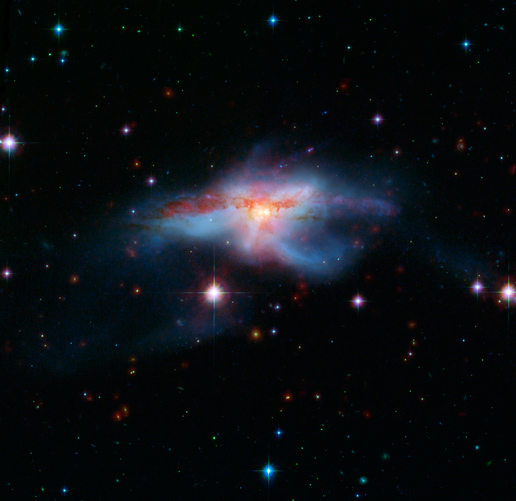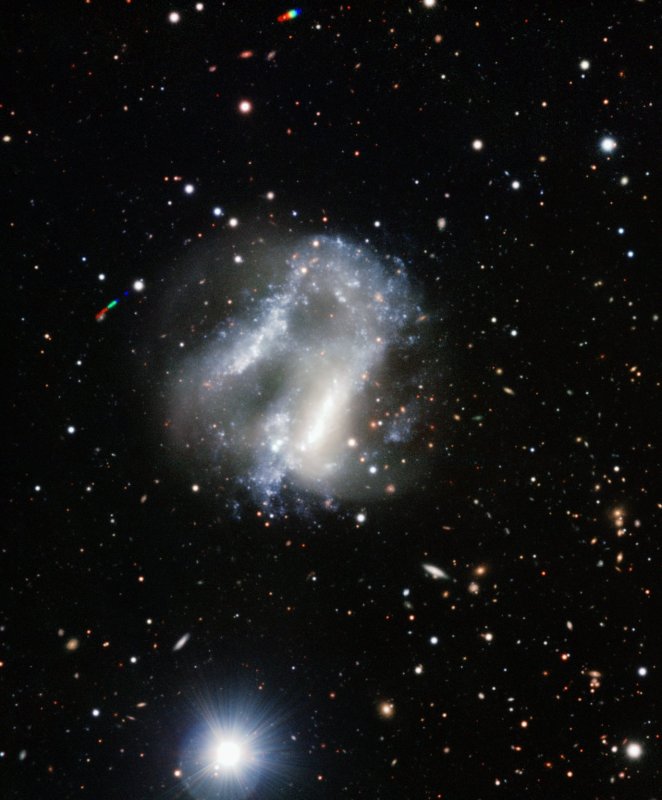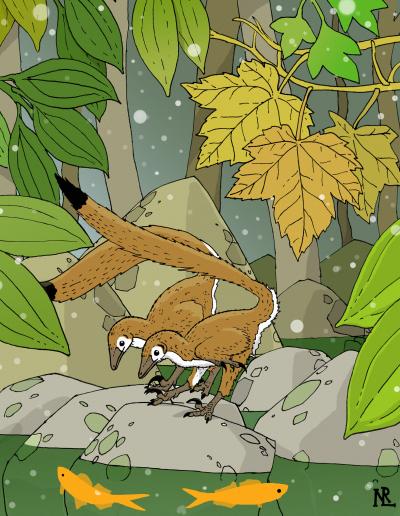Synchronized, goal-directed actions are nothing new; that concept is the foundation of civilization. But it goes much deeper than previously realized, according to research in BMC Neuroscience. It isn't just voluntary cooperation that happens, sometimes it is at the unconscious brain level.
A new study shows that when musicians play along together it isn't just their instruments that are working together, it is happening at the brain wave level also. The research details how EEG readouts from pairs of guitarists become more synchronized, a finding with wider potential implications for how our brains interact when we do.
Want to see a collision between the cores of two merging galaxies, each powered by a black hole with a millions of times the mass of the sun?
You're in luck. NASA's Spitzer Space Telescope recently caught that very thing. The galactic cores are in a single, tangled galaxy called NGC 6240, located 400-million light years away in the constellation Ophiuchus. Millions of years ago, each core was the dense center of its own galaxy before the two galaxies collided and ripped each other apart. Now, these cores are approaching each other at tremendous speeds and preparing for the final cataclysmic collision. They will crash into each other in a few million years, a relatively short period on a galactic timescale.
Sixty-one teams from Southern California, Arizona, Brazil and Chile faced off in the Los Angeles regional FIRST Robotics Competition on March 13 and 14. JPL sponsored nine of the schools in this annual engineering and technology contest held at the Long Beach Convention Center.
The teams from Centinela Valley Union High School District, Lawndale; Atascadero High School, Atascadero; and the NASA-sponsored Bishop Alemany High School, Mission Hills, won the regional competition and will compete in the FIRST championship competition in Atlanta, from April 16-19. Chaminade College Preparatory, in West Hills, won the competition's highest award, the Regional Chairman's Award, and will also go to Atlanta.
A herd of young birdlike dinosaurs met their death on the muddy margins of a lake some 90 million years ago, according to a team of Chinese and American paleontologists that excavated a site in the Gobi Desert in western Inner Mongolia. The sudden death of the herd in a mud trap provides a rare snapshot of social behavior. Composed entirely of juveniles of a single species of ornithomimid dinosaur (Sinornithomimus dongi), the herd suggests that immature individuals were left to fend for themselves when adults were preoccupied with nesting or brooding.
Sometimes different is good. You may not want a strange cup of coffee when you go to Starbucks and you would like for your car to work the way cars should, but in science the peculiar can teach us a lot.
This was the idea behind
Halton Arp’s catalogue of Peculiar Galaxies that appeared in the 1960s. One of the oddballs listed there is Arp 261, which has now been imaged in more detail than ever before using the FORS2 instrument on ESO’s Very Large Telescope.
Massive predators like Albertosaurus and Tyrannosaurus rex may have been at the top of the food chain, but they were not the only meat-eating dinosaurs to roam North America, according to Canadian researchers who have discovered the smallest dinosaur species on the continent to date. Their work is also helping re-draw the picture of North America's ecosystem at the height of the dinosaur age 75 million years ago.
 Study: Caloric Restriction In Humans And Aging
Study: Caloric Restriction In Humans And Aging Science Podcast Or Perish?
Science Podcast Or Perish? Type 2 Diabetes Medication Tirzepatide May Help Obese Type 1 Diabetics Also
Type 2 Diabetes Medication Tirzepatide May Help Obese Type 1 Diabetics Also Life May Be Found In Sea Spray Of Moons Orbiting Saturn Or Jupiter Next Year
Life May Be Found In Sea Spray Of Moons Orbiting Saturn Or Jupiter Next Year









